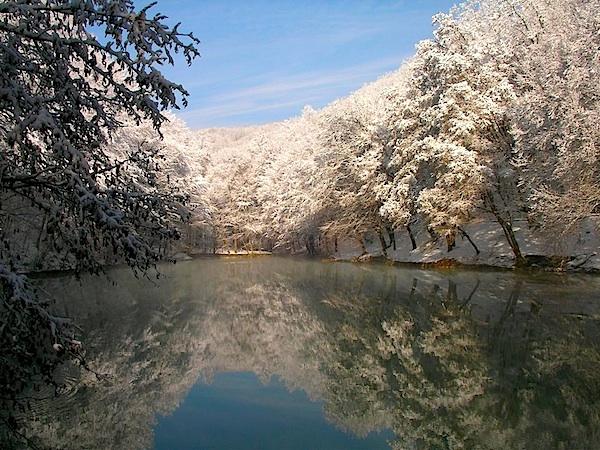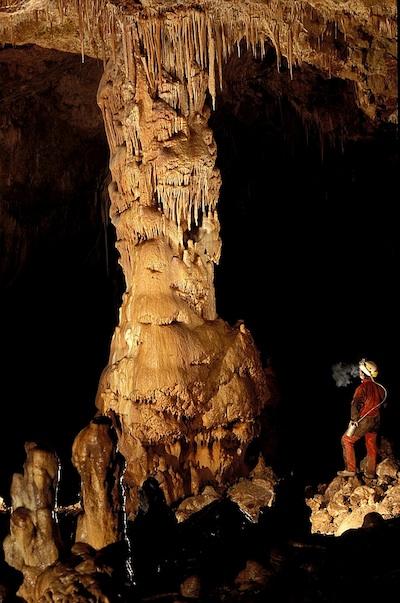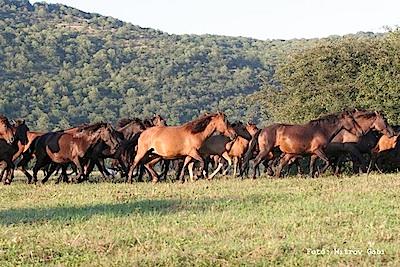Editor's note: Aggtelek National Park in Hungary is truly a unique park, with a sprawling and surprising cave system, an equestrian center, and miles of hiking and biking trails. Dan Swartz, a marketing assistant for the park, provided the following overview for Traveler readers.

Some of the waters in Aggtelek National Park. Park photo.
Aggtelek National Park in northeast Hungary features amazing karst caverns, a hucul horse riding centre, environmental education centers, and hiking and biking through Hungary's most interesting and unique landscape.
'¨Aggtelek is the only national park in Hungary established in order to first and foremost protect inanimate natural assets - karst formations and caves. The conservation of the territory began in 1978 when it was declared a "protected landscape area," and in 1985 it was recognized as a national park. Nineteen ninety-five was a significant year in the history of the national park as The Caves of the Aggtelek Karst and the Slovak Karst were declared a World Heritage Site by UNESCO. The surface disguises some 1200 caves, 280 of which can be found on the Hungarian side. The area richly deserves the extra layer of UNESCO protection on the grounds of the complexity, diversity and relatively intact conditions of its caves and formations. The total territory of the national park is more than 20000 hectares (77 square miles). It has also been a designated Ramsar Convention Site for the protection of wetlands and waterfowl.
Caving
The emblematic Baradla Cave stretches all the way across the border to Slovakia. The total length of the Baradla-Domica Cave System measures 25 kilometers (15.5 miles), of which a 5.3-kilometer (3.3 mile) long section is lying on the Slovakian side. Due to its length, activity and richness in cave formations, the Baradla Cave is undisputedly the most remarkable cave not only in Hungary, but also in this entire temperate zone. Up until the last century, it held the status of the second longest cave in the world. Although its rating has decreased in the following decades, it still unquestionably remains among the top caves worldwide. The Imre Vass Cave, Béke Cave and the Rákóczi Cave with its two subterranean lakes are also open for daily tours. Daily cave tour times can be found here.

The Meteor Cave. Park photo.
If you are seeking more adventure, there are several extreme tours on offer in the Meteor, Kossuth and Béke caves, as well as a 7-hour expedition through the Baradla Cave.
Guided and Self-Guided Tours and Hikes
Besides the cave tours, we offer guided tours ('eco-', zoological, and botanical tours) in the national park, both through picturesque villages and the forest and hills. Of course, you can always explore on your own along one of several self-guided nature trails. Regular interactive environmental education courses are held for children of all ages, as well as special tours organized in honor of World Water Day, World Animal Day, World Meteorology Day, Earth Day and other significant environmental milestones on the calendar.
Horse Riding
Aggtelek National Park is Hungary's national breeding center for the hucul horse. The breed originates in the Carpathians, and is genetically similar to ancient wild horses and the horses from the time of the Hungarian conquest in the mid- to late-10th century. The Manor House Hucul Riding Centre offers a range of activities, including riding lessons for children, trekking, horse and carriage tours and the shadow ranger tour. Full list of horse-related programs here. Not to be missed is our annual International Hucul Horse Races and International Farrier Competition every August (August 23-24, 2014). The park currently maintains a herd of more than 200 horses, and can be visited year round in the pasture about 1 kilometer from JósvafÅ.

Hucul horses can be found at Aggletek National Park. Park photo.
Cycling and Boating
Prefer wheels or boats? Bring your own bike or rent one from our fleet of mountain bike fleet and explore the Aggtelek and Slovak karst following our several bike routes. Or participate in our annual 75-kilometer (47 mile) cycle tour between the Bükk and Aggtelek National Parks. Canoe trips can be made in the Bodrogzug, where the Bodrog and Tisza rivers meet. This landscape is unique in Hungary for being the only area that still experiences regular flooding. Consequently, many of the area's natural treasures have been undisturbed, and in 1989 the Tokaj-Bodrogzug Protected Landscape Area won RAMSAR site status for its extensive waterfowl habitats.The Bodrogzug one of the finest canoeing areas in the country.
The fire salamander of course is the symbol of Aggtelek National Park, but the park is also the number one habitat for large carnivores in Hungary. The proximity of the Carpathians, and ecological corridors allowing for unhindered passage into the country, has meant the return of a number of otherwise thought to be extinct species, such as lynx and wolf. Invertebrates deserve special mention, in particular the presence of different bat species. Species found only rarely in Hungary, or even Europe, have made their habitats in the park. For example: the Greater Noctule Bat (Nyctalus lasiopterus) or Schreibers' Long-Fingered Bat (Miniopterus schreibersii).
Bird watchers will not be disappointed either. Among the raptors, there are populations of Lesser Spotted Eagle (Aqulia pomarina), Eastern Imperial Eagle (Aquila heliaca) and the Saker Falcon. Conditions are also favorable for the European Honey Buzzard (Pernis apivorus), whose numbers while not great, are stable. One may also spot the Short-Toed Snake Eagle (Cicraetus gallicus).

The fire salamander is the symbol of Aggtelek National Park. Park photo.
A variety of protected insects are represented among the fauna in the Park. For example, the Carabus zawadszkii beetle. There are approximately 2,000 types of butterflies alone, some of which are protected or on the endangered list.
See the spring orchids on our Fragile Beauties Tour in May/June, or floating sphagnum moss rarities such as the round-leaved sundew (Drosera rotundifolia) and hare's tail cotton grass (Eriophorum vaginatum) near the protected Kelemér Peat Bogs and Mossy Lakes.
Cultural Heritage
Aggtelek National Park is generously studded with castles, palaces, manor houses, forts, village museums, the MagtArt Arts Granary (nature art exhibitions), medieval monasteries and churches and other historical and cultural treasures. Within the territory of Aggtelek National Park, and with the exception of Szád Castle, the 14th c. Pauline Monastery in Martonyi is the most significant medieval building, and a monument of national importance. The newest renovated castles are the L'Huillier'Coburg Palace in Edelény, one of Hungary's largest and most magnificent baroque palaces, and BoldogkŠCastle with its stunning panoramic view from atop its mountain. The Guinness Book of World Records-holding Largest Book in the World, as well as an interesting Guttenberg Exhibition, can be seen in the village of Szinpetri.
For more information: Tengerszem oldal 1, 3758 Josvafo, Hungary Tel: (+36)-48-506-000 Email: info.anp@t-online.hu Website: http://www.anp.hu/en/mainpage/site/index https://www.facebook.com/AggtelekNationalPark http://twitter.com/AggtelekNatPark

 Support Essential Coverage of Essential Places
Support Essential Coverage of Essential Places







Comments
Hungary?? I would never have thought of going there for the outdoors.
Thanks for a look in.
Danny